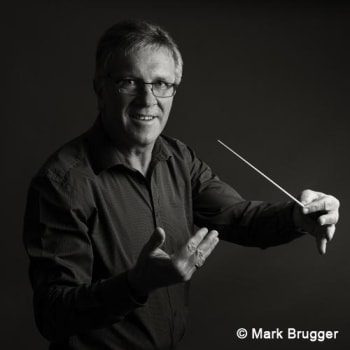
This Media Center item can only be displayed if you agree to the use of marketing cookies. With one click you can accept it.
Klang der Alpen
Info
Notes available at:
https://www.rundel.de/en/
Impressionen - Traditionen - Visionen
(Alpine Sound - 3 Movements for Concert Band)
The Alps are a fundamental and distinctive feature of Central Europe. This impressive natural spectacle inspired Kurt Gäble to write “Klang der Alpen” (Alpine Sound). As the subtitle declares, “impressions – traditions – visions” corresponding with the Alps are the center of attention. The impressions come at the opening of the piece, beginning with a motif representing vividly flowing water. This motif persists in the background almost all the time, depicting water as the ever-present basis for life. Measure 5 presents one of the main motifs of this composition, which Kurt Gäble calls “Alpenmotiv”. The horn section plays it for the first time, later supported by the trumpets. Tender sounds accompany this strong motif – a symbol for all the nuances of the Alps, which you can only see with careful observation. The unique flora and fauna of this magic world shows itself to those who take their time and treat it with reverence. Kurt Gäble uses this musical element to point out that we have to protect and preserve such a valuable treasure. A calm moment follows in measure 17, first in the brass section then joined by woodwinds. We open ourselves to the mighty and sweeping atmosphere of the Alps and try to digest and absorb these impressions. We clearly hear the water motif again. In measure 36 the “Alpenmotiv” from the beginning recurs and in measure 48 we enjoy the grandeur and depth of the massif. The music develops and leads to measure 86, becoming more tender and gentle. The traditions begin with a woodwind theme, standing for light and sun, like a musical expression of home. Each region has developed its own traditions, depending upon altitude, climate and vegetation. And traditions also connect the different areas. One striking example is the alphorn, formerly serving to communicate from alp to alp and village to village. Referring to this we hear an alphorn yodel in measure 94, accompanied by real cow bells. This sound is a distinctive element of the Alps. As randomly as the bell of each cow sounds in the mountains, so they should be played. In measure 104, the motif of the alphorns changes to a polka in two-four time. This traditional dance also connects the different Alpine areas, slightly distinguished by characteristic features of each region. A surprising break happens at measure 142. Suddenly new influences affect the traditional sound. It accelerates, is more powerful and boisterous. A fast-paced off-beat dominates this part, which shows the visions: the young generation returns to its roots searching for an approach to tradition – in a modern and fresh way. This young approach maintains respect for the past and yet is full of new inspiration and an open mind for the future. This creates a new and unique sense of home, shown in the music at measure 182, when the “Alpenmotiv” from the beginning recurs – but now in a variation that combines old and new sounds. “Klang der Alpen” ends with a bright finale, celebrating both tradition and vision.
1. Impressions: Alpen-Wunderwelt
2. Traditions: Alphorn-Jodler & Alphorn-Polkalied
3. Visionen: Neue Wege
Grade Level GB: 6-7
Grade Level USA: 4 (Advanced)
Composer: Gäble, Kurt
Genre: Concert Piece
Performance time: 9,13
Publisher: Rundel
Size: DIN A4
Info: Full Score + Parts
Rundel Order Number: MVSR2698
Release Date: 2014
https://www.rundel.de/en/
Impressionen - Traditionen - Visionen
(Alpine Sound - 3 Movements for Concert Band)
The Alps are a fundamental and distinctive feature of Central Europe. This impressive natural spectacle inspired Kurt Gäble to write “Klang der Alpen” (Alpine Sound). As the subtitle declares, “impressions – traditions – visions” corresponding with the Alps are the center of attention. The impressions come at the opening of the piece, beginning with a motif representing vividly flowing water. This motif persists in the background almost all the time, depicting water as the ever-present basis for life. Measure 5 presents one of the main motifs of this composition, which Kurt Gäble calls “Alpenmotiv”. The horn section plays it for the first time, later supported by the trumpets. Tender sounds accompany this strong motif – a symbol for all the nuances of the Alps, which you can only see with careful observation. The unique flora and fauna of this magic world shows itself to those who take their time and treat it with reverence. Kurt Gäble uses this musical element to point out that we have to protect and preserve such a valuable treasure. A calm moment follows in measure 17, first in the brass section then joined by woodwinds. We open ourselves to the mighty and sweeping atmosphere of the Alps and try to digest and absorb these impressions. We clearly hear the water motif again. In measure 36 the “Alpenmotiv” from the beginning recurs and in measure 48 we enjoy the grandeur and depth of the massif. The music develops and leads to measure 86, becoming more tender and gentle. The traditions begin with a woodwind theme, standing for light and sun, like a musical expression of home. Each region has developed its own traditions, depending upon altitude, climate and vegetation. And traditions also connect the different areas. One striking example is the alphorn, formerly serving to communicate from alp to alp and village to village. Referring to this we hear an alphorn yodel in measure 94, accompanied by real cow bells. This sound is a distinctive element of the Alps. As randomly as the bell of each cow sounds in the mountains, so they should be played. In measure 104, the motif of the alphorns changes to a polka in two-four time. This traditional dance also connects the different Alpine areas, slightly distinguished by characteristic features of each region. A surprising break happens at measure 142. Suddenly new influences affect the traditional sound. It accelerates, is more powerful and boisterous. A fast-paced off-beat dominates this part, which shows the visions: the young generation returns to its roots searching for an approach to tradition – in a modern and fresh way. This young approach maintains respect for the past and yet is full of new inspiration and an open mind for the future. This creates a new and unique sense of home, shown in the music at measure 182, when the “Alpenmotiv” from the beginning recurs – but now in a variation that combines old and new sounds. “Klang der Alpen” ends with a bright finale, celebrating both tradition and vision.
1. Impressions: Alpen-Wunderwelt
2. Traditions: Alphorn-Jodler & Alphorn-Polkalied
3. Visionen: Neue Wege
Grade Level GB: 6-7
Grade Level USA: 4 (Advanced)
Composer: Gäble, Kurt
Genre: Concert Piece
Performance time: 9,13
Publisher: Rundel
Size: DIN A4
Info: Full Score + Parts
Rundel Order Number: MVSR2698
Release Date: 2014
Recommended Articles
Klang der Alpen
The Alps are a fundamental and distinctive feature of Central Europe. This impressive natural spectacle inspired Kurt Gäble to write “Klang der Alpen” (Alpine Sound). As the subtitle...Concert Band
MVSR2698
Recommended Persons
Kurt Gäble
* 05.01.1953
Composer, arranger, conductor, musician and music teacher Kurt Gäble was born in 1953. He has dedicated his life to music, especially wind band music. The course for this was already set in early childhood, when singing together with the mother as a pastime while doing various household chores. The recorder followed and over time many other instruments, all of which the autodidact taught...Info

